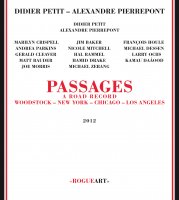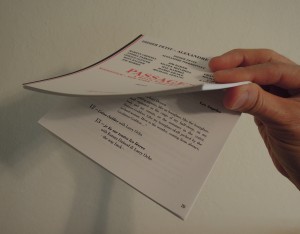 It’s been a couple of weeks since I took in this show at Berkeley Arts Festival: Joe Lasqo playing piano against a computerized improviser, and the improv quartet Gestaltish.
It’s been a couple of weeks since I took in this show at Berkeley Arts Festival: Joe Lasqo playing piano against a computerized improviser, and the improv quartet Gestaltish.
Lasqo’s digital partner was his artificial-intelligence program called Maxxareddu, and there’s a really interesting side-story to that. In July, Maxxareddu will perform in a duet with Maxine, an AI created by Ritwik Banerji of UC Berkeley’s Center for New Music and Audio Technologies (CNMAT). Two machines conversing musically, without human intervention.
That’ll be part of the Outsound New Music Summit (exact schedule still TBA). Lasqo said he’ll be putting a lot of work into Maxxareddu during the next few months.
For the performance I saw, Lasqo let Maxxareddu wander, adding his own piano to the mix. All improv is unpredictable, but the AI element, from a performer’s point of view, seems to be unpredictable in a different way. “Sometimes I find I’m learning from this thing I was trying to teach,” he said, introducing the show.
 There’s certainly something myserious about the self-recursive nature of Maxxareddu’s learning process. The images Lasqo chose for previewing the show on his blog included a clock curling in on itself and the space-warping, mirrored installations of Kasuma Yayoi.
There’s certainly something myserious about the self-recursive nature of Maxxareddu’s learning process. The images Lasqo chose for previewing the show on his blog included a clock curling in on itself and the space-warping, mirrored installations of Kasuma Yayoi.
Being the human in the duo, Lasqo held the right to decide when phase or a piece should end, but that did require the push of a button (removing one hand from the piano keyboard, although he could pretty easily do that without harming the music). Each new set of sounds can take a bit of setup, although that’s not much different from a string player adjusting to a different tuning, as Lasqo pointed out — but it did mean Maxxareddu stuck to one type of sound per piece.
The set started with what might have been the most difficult of the pieces with Maxxareddu’s spouting bubbly, cartoony voices, altered and pitched and mangled. Against that, Lasqo laid down calm piano bits, a zen response. Next, he changed Maxxareddu to a more metallic set of sounds, sometimes like coins being shuffled like cards. The more active setting made it more natural for Lasqo to add occasional bursts of speed and even a fist bump or two on the piano, but his playing always kept a layer of tonality in mind, like a musical grounding for the electronics.
The final piece felt the most natural to my ears, probably because Maxxareddu was holding to calm, chiming notes, providing a tonality for the first time. Eventually, that gave way to a thin electronic hum.
I sometimes had trouble linking the piano and electronics directions in my mind, something that’s often a problem for me in acoustic + laptop situations. And I’m not sure if it’s possible for the audience to “hear” how Maxxareddu makes its decisions. Still, it was a very enjoyable performance, and the whole idea of AI in music intrigues me.

Gestaltish is a quartet that brings a kitchen sink of sonic possibilities to the stage — a fistful of reeds; prepared piano and guitar; vocals; and percussion everywhere.
They tended towards the quieter side of abstract improv but were willing to ride the snatches of melody or rhythm that would evolve, particularly out of the guitar. (Jacob Peck overtly spun some soft jazzy chords at a couple of points.)
Jennifer Wilsey on piano added some melodic structure — or some additional percussion, if it was prepared piano. She also got a lot of mileage and variety out of her snare drum, sometimes filling the drum head with a cymbal for a muted sound that made me think of falling sand.
Most of the focus fell to clarinetist Rachel Condry (also of the SF Chamber Composers Orchestra — see here) and vocalist Gretchen Jude. They would frequently stumble onto dissonant harmonies that they would ride out, letting the long notes hold and vibrate.
 They combined for a duo to end the set, a goofy dialogue starting with both of them giving each other a surprised “HI THERE!” expression and then launching into barks and squiggles. It was fun.
They combined for a duo to end the set, a goofy dialogue starting with both of them giving each other a surprised “HI THERE!” expression and then launching into barks and squiggles. It was fun.
Gestaltish’s set took a little while to warm up. On earlier pieces, they seemed to be waiting for each other to start. But the group soon found its groove and settled into some good communication. The second-to-last piece was particularly nice, as they built up an elegy, a soft melodic space starting with slow piano lines. They’d done well with the jumps and swoops of improvising in the rest of the set, but this was an interesting change of pace, one that sprang up organically.
 Cool avant-rock show happening Sat. Feb. 23 at The Starry Plough in Berkeley:
Cool avant-rock show happening Sat. Feb. 23 at The Starry Plough in Berkeley:







